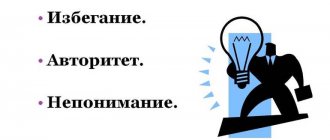How to deal with panic? How to reduce or completely get rid of disturbing fear and anxiety? Below is a detailed description of the EMDR technique for independent use, which allows you to get rid of your anxiety forever in just 1-2 sessions.
EMDR (Eye Movement Desensitization and Reprocessing) is a method of changing emotional memories of various situations. Desensitization means removing an emotion.
The technique was developed by Francine Shapiro (USA) in 1989. She, being in a very difficult emotional state (her husband left, she defended her doctorate, breast cancer), walked through the park and suddenly felt an improvement. I analyzed why this happened and found that the improvement occurred as a result of moving my gaze left and right behind the “sunbeams.”
Later, after research on this topic, a clear scheme for the operation of the EMDR technique was developed and justified. We will discuss the mechanism of its action a little later.
Advantages
— Compared to the same psychoanalysis, the EMDR technique is short-term. For example, one fear can be completely and irrevocably removed in 2 hours of work.
- Compared to behavioral techniques (the therapist takes you by the hand, and you go down to the subway together, or approach an elevator, a spider, an airplane, etc.), you do not need to actually encounter objects that cause anxiety, fear - it is enough to imagine them.
— Compared to hypnosis, it is absolutely safe, there is no artificial intervention in the psyche. EMDR is a natural psychophysiological process). This technique can be used with both children and the elderly.
— Compared to almost any direction in psychology, you can use this technique yourself.
— Transparent for the client: in comparison with other areas in psychology, where everything is quite blurry and unclear what exactly will happen to you, in what ways, in what time frame, etc. – everything is transparent and clear here: at the very first meeting, the client receives clear information about how his request will be resolved.
— Helps in solving a huge range of queries: anxiety, fear, panic attacks, somatic disorders, stress, anger, guilt, acute grief, dissociative disorders, PTSD, violence.
Benefits
- You save YOUR time. The average time to eliminate one experience, fear, is 2-3 hours.
- You save YOUR money.
- Effective. You get 100% results here and now. A processed client request will not be returned in the future. Those. the client is forever freed from processed fear, for example, fear of speaking.
- Effective. Effective against phobias, fears and worries 99%. Of all my clients, with only one the technique did not give the desired results due to the lack of a client-psychologist report (personal factor).
- Just. The EMDR technique is very easy to use, as you will soon see.
- Available. You can use it yourself, even when traveling by train, car or plane.
— 100% applicability to any age (starting with children 3 years old and older).
Confirmation of the effectiveness of the technology.
So, this technique works in a short time and its effectiveness is extremely high: this is the technique that EMERCOM psychologists use in hot spots, in places of terrorist attacks. This equipment is also included in voluntary insurance in Europe and the States. The only limitation is dysfunction of the cerebral cortex. Such people are contraindicated to experience strong emotions.
Nyam
If you practice meditation diligently, sooner or later difficult experiences may arise - even if your psyche is stable, you have enough experience in meditation, and everything is in order with your technique. Many meditation teachers talk about the need to go through special stages in practice during which painful emotions or simply strange and unusual experiences arise. In the Tibetan Buddhist tradition, this type of experience is referred to as “nyam.” “Nyam” is a short-term abnormal mental and/or somatic experience. It is caused by proper meditation and is a sign of progress.
At the body level, nyam can be expressed as nausea and dizziness. Psychologically - as depression, paranoia, awe, crying, sadness and even a feeling of bliss. How to react to such experiences and should they be considered the norm? Meditation teacher and researcher Alan Wallace recommends staying calm and using common sense. If your experiences seem to indicate health problems, go to the doctor. If you think an experience is nyam, don't stop it from happening. “Just be present in the experience, without hope or fear,” says Wallace. “If it’s a nyam, it will end the same way it started.”
So, within traditional views of spiritual practice, painful emotions or simply strange and unusual experiences during meditation are a natural part of training and developing the mind. By the way, neuroscientist Willoughby Britton also came to the conclusion that negative effects are a natural part of the process in her acclaimed study of the negative effects of mindfulness practices. One of Britton’s key ideas is this: in training, you need to focus on those mental functions and skills that are in short supply. When they turn into a hypertrophied form, undesirable effects appear. Let's say a certain person lacks bodily awareness. In this case, focusing on the body and scanning bodily sensations will benefit him. But if attention to the body is excessive and intrusive, it will be combined with a feeling of anxiety.
Procedure
Above, we indicated that there are various internal factors that can reduce the quality of our life, including the quality of running our business: outbursts of anger, fears (of performances, flights, negotiations, etc.), experiences of acute grief, self-blame. Now we’ll talk about how you can, if you can’t see a specialist, independently reduce or completely get rid of a disturbing emotion.
So, we have to go through several stages:
1. Preparatory stage;
2. determination of the subject of influence;
3. desensitization;
4. installation;
5. scanning.
Preparatory stage
The goal is to prepare and get ready for work. Globally, we will remember unpleasant episodes of our life while simultaneously moving our eyes left and right. In order to set the desired tempo for these movements, we will need audio recordings of the sets.
So, we need to prepare sets - audio recordings in 40-second segments, on which the alternating pronunciation of the sounds “ER” - “PE” is recorded. We will then move our eyes left and right to these sounds. The sounds “ER” - “PE” can be replaced with any others, it is not of fundamental importance. Main:
- they must be pronounced at intervals of 0.5-1 seconds.
- be unpredictable, i.e. pronounced not monotonously and evenly, but sometimes in a quieter - sometimes in a louder voice, sometimes a little faster - sometimes slower.
The second condition is that the unpredictability of sounds (changing volume and tempo) helps a person to be in the present with his body, while his thoughts are completely in the past. On the one hand, this fact ensures the client’s safety, on the other hand, it puts him in a trance state, in which he gets rid of fear.
We make 5-6 audio recordings (sets), slightly different from each other in the pronunciation of “ER” - “PE” in volume and tempo. This is necessary so that our psyche does not remember the set, and thus does not go into offline mode. The autonomous mode is characterized by the fact that we already know that “ER” will now be pronounced and we will need to move our gaze to the right, and we, ahead of the “ER” sound, begin to move our eyes. If this happens, the work loses its effectiveness.
Why is efficiency decreasing? The fact is that if we saw ourselves from the outside, we would notice an interesting fact. A person’s eyes first move smoothly left and right, then seem to jerk. These “jerks” indicate a person’s trance state, during which active relief from the disturbing emotion occurs. In offline mode, the trance state does not occur.
*Eye movements can be replaced by patting the knees. For some people, eye movements cause discomfort; for others, it is easier to focus on memories. The effectiveness is the same in both cases.
Determination of the subject of influence
The goal is to find the “target” of the influence - what exactly we will imagine when performing eye movements.
The first thing we do is take a piece of paper and a pen, and write down the last few situations, the first that come to mind, in which we reacted inappropriately. What does inadequate mean? For example, at an important business meeting, when communicating with partner N, there was very strong anxiety, although the partner behaved without provoking this emotion. The anxiety intensified when he looked into the eyes or fell silent. That is, you understand that if your friend Kostya, for example, were in your place, he certainly would not have reacted this way. No one shouted at you or judged you, but you were extremely worried.
So, we designate 2-3 similar situations. We just give them a serial number and a name. For example:
1. Business meeting 02.12.16
2. Appointment with a specialist
3. Stopped by a traffic police inspector
Second, we evaluate on a 10-point (0 - not bothered; 10 - very much bothered) scale of emotional concern how unpleasant it is for us to remember this event.
1. Business meeting 02.12.16 – 9.
2. Appointment with a specialist – 9.
3. Stopped by traffic police inspector - 10.
Third, we indicate on a 10-point scale what negative emotions, what uncomfortable bodily sensations there were (burning in the chest, tension in the throat, wobbly legs, etc.). We also evaluate on a 10-point scale what attitude - the predominant destructive (wrong) thought about oneself - sounded in the head: “I am bad”, “the world is dangerous”, “I am humiliated, helpless”, etc.
The setting must contain the pronoun “I”, “me”; If possible, it is better not to use the particle “not”. Usually, in the first situations that come to mind, there are approximately the same bodily reactions, emotions, and attitudes. And, as we will see later, in most cases they are all characterized by one common past event.
So, we come to one very important point. As a result of a strong emotional shock, a negative self-image is formed (“I am powerless,” “I will be betrayed,” etc.). Negative self-image, in turn, gives rise to inadequate reactions (fear at the “not scary”, anger at the “harmless”, etc.). Inappropriate reactions are disproportionately strong emotions, bodily sensations that do not correspond to the stimulus.
A few examples.
Accident. While getting off the tram, he is hit by a car. The attitude “I am in danger” is formed, and it is triggered in seemingly worthless situations: the sound of an approaching tram, being near a stop where an accident occurred. At such moments, the body contracts in the diaphragm, breathing becomes rapid, the legs become cold, and the thought in the head is “I’m in danger.”
Violence. At night there is a sudden attack on the street. The attitude “I am helpless” is formed. Fear of crowds and darkness develops. In crowded places and in the dark, a person begins to experience unpleasant bodily and emotional reactions, almost identical to those experienced at the time of the attack.
Fourth, we determine the “target” for work. Of all the listed events, we choose the one that is most charged in terms of points. If there are several events with the same scores, we choose the one that has more physical or emotional manifestations. In this case, this is situation No. 3 “Traffic Inspector”. We replay situation No. 3 in our heads like a film from beginning to end and find the “peak” of the emotional parabola – the point at which we are most uncomfortable. This peak is the “target” of the impact; you can move on to the next stage.
Desensitization
The goal is to remove the negative emotion from the traumatic memory. In short, at this stage, attention is focused on a past event while simultaneously moving the eyes left and right.
So, we have identified the target of influence and we have recordings of the sets. We will also need a notebook and pen. You can begin the main stage of work - desensitization. We need complete silence and the absence of disturbing factors (phone, person). We sit comfortably in the chair. Let's remember event No. 3. We need not just to remember the past, but to experience it as vividly as possible. To do this, we use all the senses:
- vision - focus on this picture (you can take a “photo”),
- touch - we try to remember that we felt the temperature with our body (cold-hot), maybe touch;
- hearing - what sounds we heard (silence, noise);
- sense of smell - smells.
This technique will help you remember the traumatic event more clearly. The strength of this brightness is directly proportional to the speed and quality of getting rid of the disturbing emotion. So, it is extremely important for us to dive deep into the past. Deep immersion is accompanied by vivid emotions and bodily sensations. As soon as we feel maximum discomfort, we simultaneously do the following:
— keep the “picture” of the event before our eyes;
— concentrate on the sensations in the body;
— silently or out loud we pronounce a destructive attitude (“I’m in danger”, “there’s something wrong with me”, etc.);
— turn on the audio recording of the set and perform eye movements left and right to it, or alternately pat yourself on the knees (shoulders). You can use both eye movements and tapping at the same time. Eye movements are performed with the maximum possible amplitude, while the head does not move; Patting can be of any strength that is comfortable for you.
At the end of the set, the task is to completely return to the “here and now.” To do this, we take a deep breath and exhale, perform slow movements of the head as far as possible to the left and right, looking at the details of the surrounding environment. Next, we write down the following information in a notebook: scores on the ESB (emotional anxiety scale), list the emotions and bodily sensations that we experienced during the set. If there were any thoughts, insights (insights), we also note them.
Let's move on to the next set. And so on, set after set, until we reach 1-2 from 10 points. On average, it takes 60-90 minutes to process one experience. During processing, the following things can happen to us:
a) remembering earlier events;
b) insights - positive thoughts and insights;
c) new emotions (rage, anger).
A). So, we can be “thrown back” to an even earlier past, such as childhood or adolescence. We can even remember how it all started, for example, the details of an accident that we have never remembered in our lives. Almost each of us has noticed that during a quarrel, we remember a bunch of things that, it would seem, we have already “passed over” a long time ago.
This happens because, being in emotions of fear, anger, etc., we involuntarily remember all the situations in which we experienced similar experiences. This phenomenon manifests itself due to associative connections. What to do if an earlier event(s) are “discovered”? First, we evaluate it on a scale of emotional anxiety. If the score is 8 or more, then we include this event in our work, if less, then we leave it without attention.
There may be several secondary events - we select the most striking of them. Next, we compare the initial event (with which we started work) and the secondary event (which we remembered during the work). If the secondary event has more points on the scale of emotional anxiety than the initial one, then we work on it separately according to the principle described above. If both events are approximately equal in points, then in one set we scroll through both events in turn. For example, the first 20 seconds are one thing, 20 seconds are another.
So, the priority is always the event that has higher scores. It is interesting that when working through the most vivid secondary memory (if there are several of them), the others, including the initial one, also lose their emotional charge. This phenomenon is called generalization.
b). Insights. Approximately in the second half of the work, positive thoughts begin to appear. For example, “I am not to blame for anything,” “I did everything I could,” “probably my father’s parents treated him the same way, that’s why he is like this,” “this is already in the past,” etc. What to do with insights? Every positive thought needs to be “reinforced.”
To do this, we devote one set separately to one insight: we scroll through a positive thought in our head and perform eye movements (patting). At this stage of work, through eye movements, we activate those areas of the brain that are responsible for alternative (positive) associative connections. They are our resource - a resource that is involved in extinguishing negative emotions. Next, we return to working through the traumatic event.
V). New emotions. Emotions may arise during the work. Usually, anxiety, fear, and feelings of guilt are replaced at a certain moment of processing (closer to the middle) by rarely rage, more often by anger. What to do in this case. Things that help in reacting to anger are added to the classic picture of the work and the process takes on the following form:
— keep the “picture” of the event before our eyes;
— we don’t just concentrate on the sensations in the body, but strain our muscles: we clench our fists, clench our jaws, and press our back with force into the back of the chair;
— silently or out loud (with priority) we pronounce the feeling of anger (I hate you, you ruined my life, etc.);
— turn on the audio recording of the set and perform eye movements left and right to it, or alternately pat yourself on the knees (shoulders).
.You can, if possible, go outside, shout, do push-ups, etc. Express anger in any acceptable way. When we reached 1-2 points on the emotional scale of anxiety, i.e. We no longer experience negative emotions, we can move on to the next stage.
Installation
The goal is to establish a positive self-image. First, at this stage we need to select an alternative attitude - a positive, positive self-image. If it was “I’m bad” - then now “I’m good”, if “I’m somehow not like that” - then “I am who I am”, etc. Second, evaluate this attitude on a seven-point scale (0 - I don’t believe that I am like that at all; 7 - yes, this is definitely about me). Next, we move on to the installation procedure itself:
— we keep before our eyes the “picture” of the initial event;
— silently or out loud we pronounce a constructive attitude (“I am safe”, “I am worthy of good things”, etc.);
— turn on the audio recording of the set and perform eye movements left and right to it, or alternately pat yourself on the knees (shoulders).
After about 15-30 minutes of work, you will believe by 6-7 points that you are safe, worthy of good things, etc.
Two approaches
So, a certain person is just getting acquainted with meditation. At this moment, it is extremely important in what conditions he meditates. The same attention management technique can be toxic or therapeutic, depending on how the process is organized.
For example, in one of the most popular traditional schools of Buddhist meditation, the training format is a 21-day intensive retreat. Anyone who wants to get acquainted with meditation can participate. During the retreat, the student commits to practice with increasing difficulty almost around the clock. In the last days, the mentor gives the student the task of not going to bed, not changing clothes, not taking a shower. In such a depleting mode, the risk that psychological problems and unpleasant bodily sensations manifest themselves during meditation becomes maximum. This retreat is a radical example of an unsafe environment for mindfulness practices, especially for beginners. But many, however, are inspired by this experience - precisely because of its extremeness, unusualness and intensity.
The conditions that minimize risks for beginners look very different. Now mindfulness practices are actively used in psychotherapy: the therapist teaches the client simple meditation techniques so that he can improve his ability to emotionally regulate and quality of life. Typically the client meditates for no more than 20 minutes a day. The therapist monitors how his condition changes and, if necessary, adjusts the recommendations: he suggests a different technique or slightly changes the instructions. The likelihood that a person will have a negative experience from the practice is minimal. This option - meditation for no more than 30 minutes a day, with the support of a psychologist or instructor - is primarily needed by people who have a mental disorder or addiction, as well as those who have experienced trauma.










